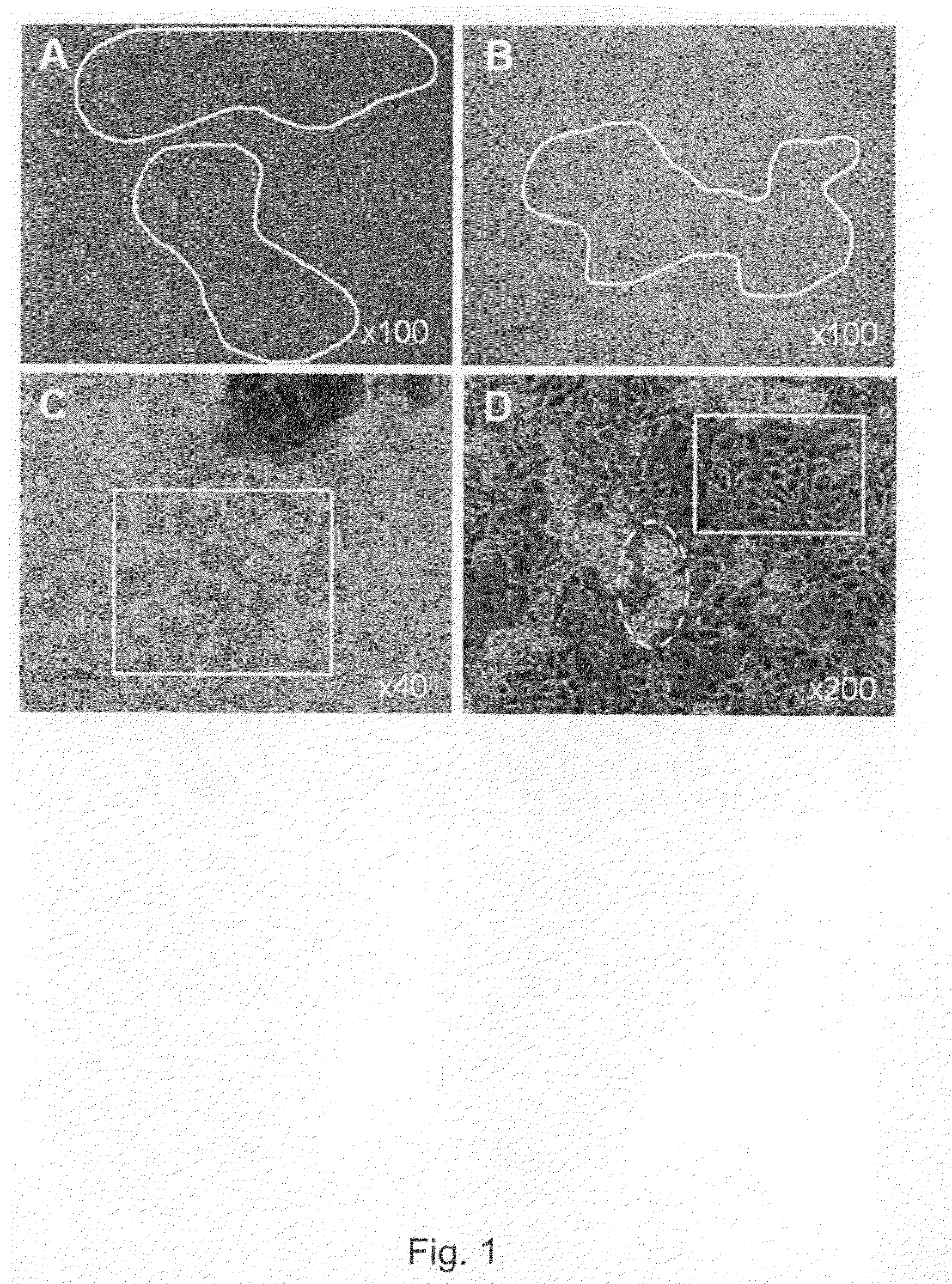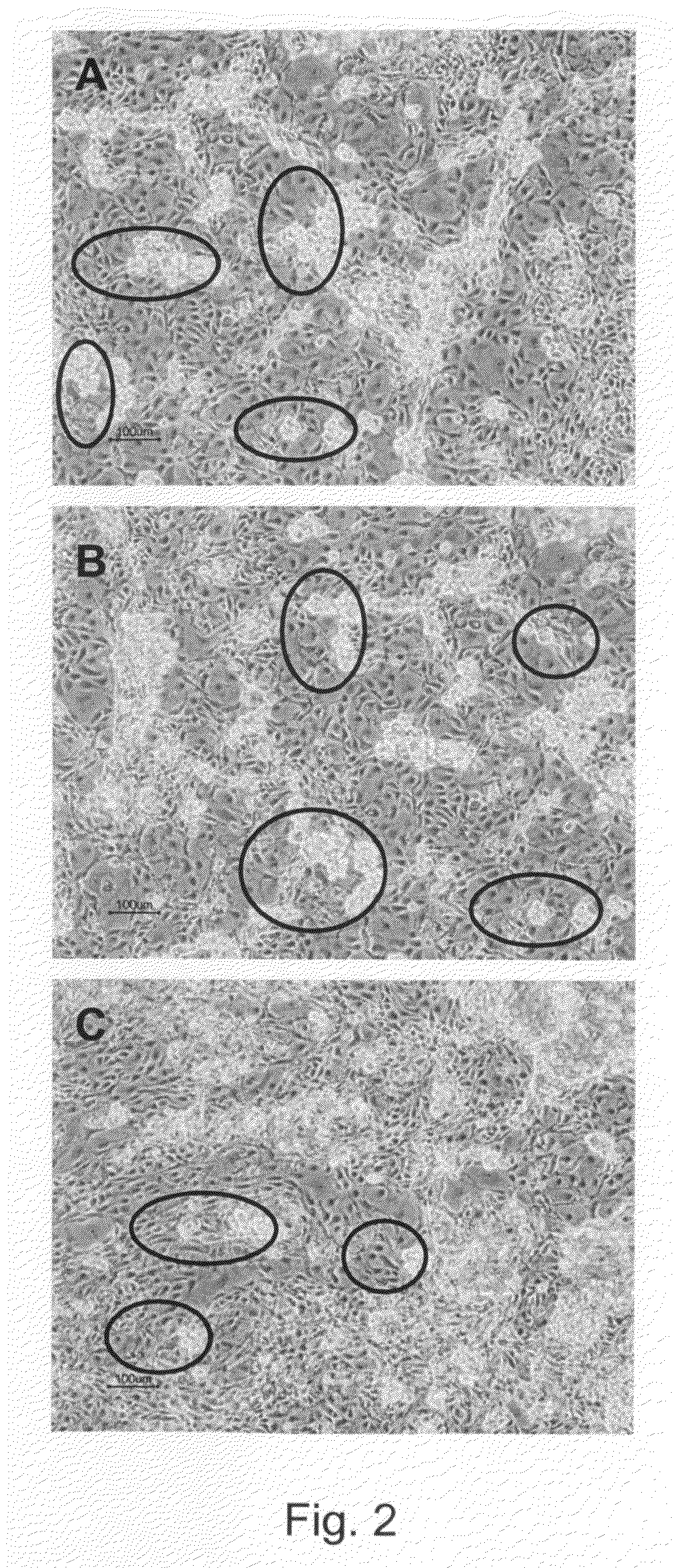Novel population of multipotent cardiac precursor cells derived from human blastocysts derived stem cells
a multi-potent, stem cell technology, applied in the direction of skeletal/connective tissue cells, drug compositions, immunological disorders, etc., can solve the problems of large burden on the health care system, large number of deaths, and high cost of this intervention
- Summary
- Abstract
- Description
- Claims
- Application Information
AI Technical Summary
Benefits of technology
Problems solved by technology
Method used
Image
Examples
example 1
[0300]Derivation of Basement Cells from Undifferentiated hBS Cells
[0301]Suspension Culture
[0302]Undifferentiated hBS cells were maintained and propagated in vitro. At day 4-5 after passage undifferentiated hBS cell colonies were manually dissected using a Stem Cell Cutting Tool and placed in differentiation medium (KO-DMEM supplemented with 1 mM Glutamax, 0.1 mM β-MeOH, 1% NEM, 1% PeST and 20% FBS) in suspension cultures. The cells were maintained in suspension for 1-6 days and subsequently transferred to gelatin-coated tissue culture dishes leading to adhesion of the differentiating cell clusters and continued proliferation and differentiation of the cells. Four days after plating a monolayer of cells appear from the adherent clusters of differentiating hBS cells. These cells grow in a characteristic tight network with appearance resembling a maze which makes areas of basement cells easy to distinguish using light microscopy. The morphology of the basement cells share similarities ...
example 2
[0305]Characterization of Basement Cells
[0306]Basement cells were derived from undifferentiated hBS cells as described above. They were cultured in differentiation medium (KO-DMEM supplemented with 1 mM Glutamax, 0.1 mM β-MeOH, 1% NEM, 1% PeST and 20% FBS) for up to 37 days. Cells were fixed at various time points in PFA and evaluated by immunohistochemistry (Noaksson et al Stem Cells 2005). Antigen markers used were vimentin, desmin, α-sarcomeric actin and brachyury. The basement cells expressed α-sarcomeric actin and brachyury (FIG. 9) but not vimentin and desmin. Cell lines used were SA002, LOTAL002 (passage 26), SA002.5, LOTBE002.5 (passage 32) and SA461, LOTBF461 (passage 33).
[0307]Table I summarizes the obtained results of the IHC analysis of basement cells.
TABLE IAntigenDays ofmarkerDifferentiation*ResultAntibody infoVimentin25Negativemouse anti-vimentin antibody,V-6630, SigmaDesmin25Negativemouse anti-desmin antibody,MAB1698, Chemiconα-36Positivemouse anti-alpha sarcomericsa...
example 3
[0310]Micro Array Analysis of Basement Cells
[0311]Cell Culture and Differentiation
[0312]The hBS line SA002 (Cellartis AB, Göteborg, Sweden, http: / / www.cellartis.com) was propagated and the cells differentiated to basement cells as described above, forced aggregation, example 1. Using light microscopy clusters of basement cells were identified and mechanically isolated using a Stem Cell Tool. For comparison purposes in the micro array experiments, samples of undifferentiated hBS cells, samples from a mixed population of differentiated hBS cells (i.e., no basement cells present), and samples from spontaneously contracting cardiomyocyte-like cells derived from hBS cells (Norström et.al 2006, Kehat et.al. 2001) were collected and included in the analysis.
[0313]Samples: 1. Undifferentiated hBS cells (passage 33, 36, 37, 39, and 40)[0314]2. Basement cells (passage 22, 23, 26-28, 32, 33, 36, and 37)[0315]3. Mixed population of differentiated hBS (passage 22, 28, and 32)[0316]4. Cardiomyocy...
PUM
 Login to View More
Login to View More Abstract
Description
Claims
Application Information
 Login to View More
Login to View More - R&D
- Intellectual Property
- Life Sciences
- Materials
- Tech Scout
- Unparalleled Data Quality
- Higher Quality Content
- 60% Fewer Hallucinations
Browse by: Latest US Patents, China's latest patents, Technical Efficacy Thesaurus, Application Domain, Technology Topic, Popular Technical Reports.
© 2025 PatSnap. All rights reserved.Legal|Privacy policy|Modern Slavery Act Transparency Statement|Sitemap|About US| Contact US: help@patsnap.com



